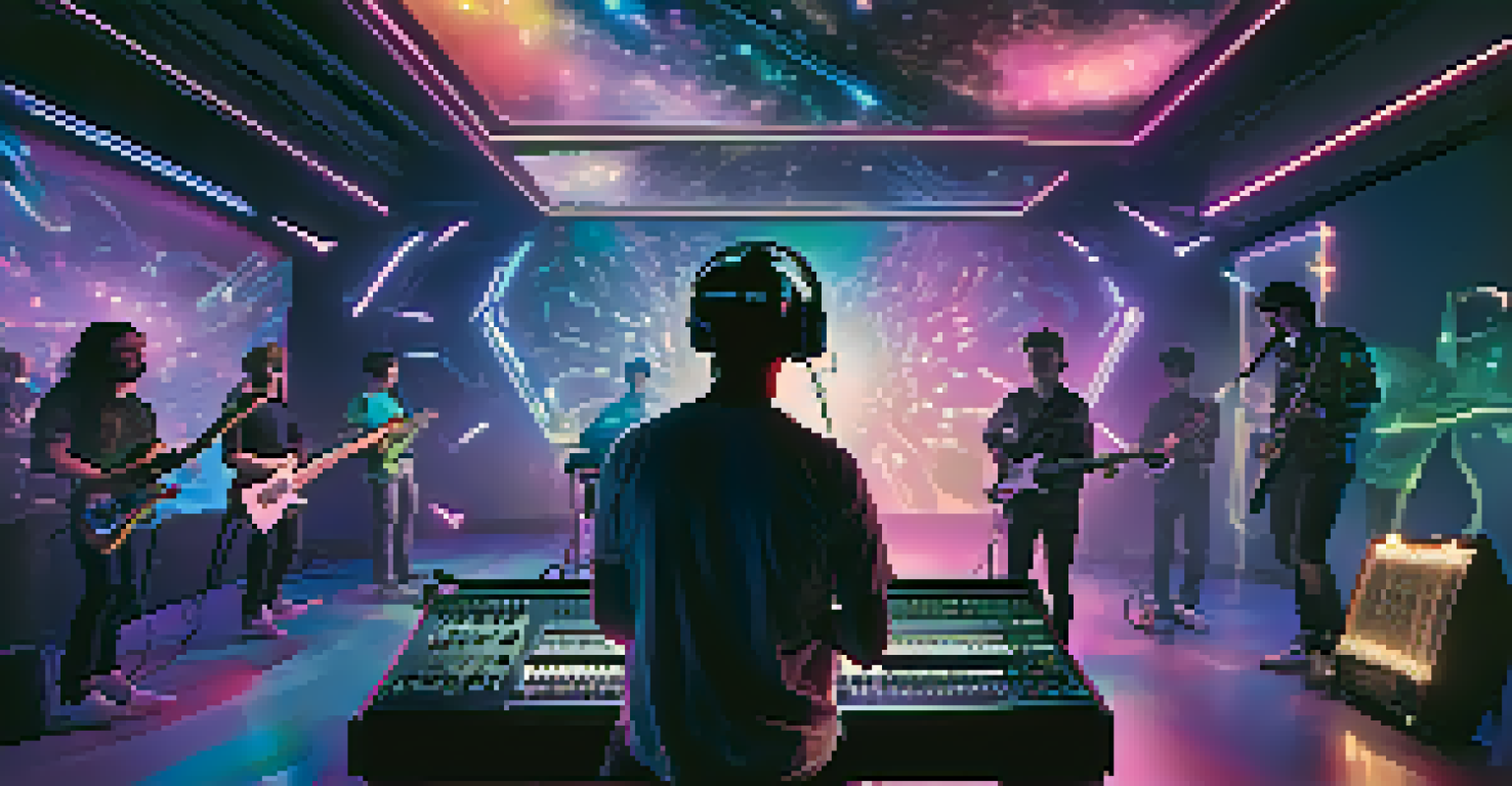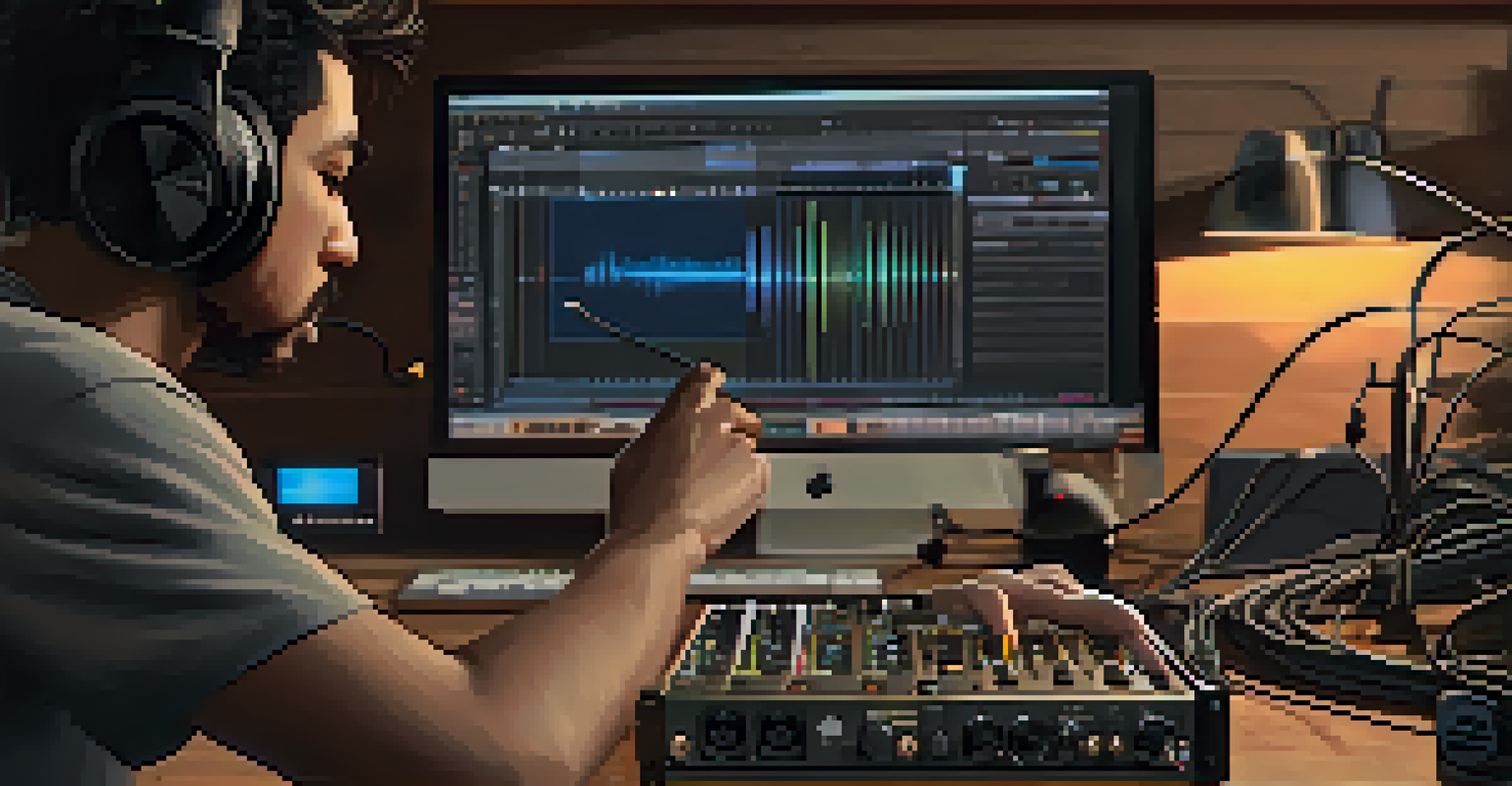Remote Jamming: Overcoming Latency Challenges in Music

Understanding Latency in Remote Music Collaboration
Latency refers to the delay that occurs between a musician's input and the sound that is produced. In remote jamming, this delay can disrupt the fluidity of musical interaction, making it difficult for artists to sync up their performances. Imagine trying to play a duet over a video call, where you hear your partner a split second later; it can be frustrating and disorienting.
Music is the shorthand of emotion.
There are various factors that contribute to latency, including internet speed, the quality of audio interfaces, and even the software being used. Each of these elements can introduce delays that accumulate, leading to a less-than-ideal jamming experience. For musicians, understanding these factors is crucial in finding ways to mitigate the impact of latency.
Fortunately, advancements in technology are helping to tackle these latency issues. Musicians now have access to specialized software and hardware designed specifically for remote collaboration, allowing for a more seamless jamming experience. The goal is to create an environment where distance doesn’t hinder creativity.
The Impact of Latency on Musical Performance
Latency can significantly affect timing, which is essential for any musical performance. When musicians play together, they rely on each other’s timing cues, and even a slight delay can throw off the entire rhythm. This can be particularly challenging in genres like jazz or rock, where improvisation is key and timing is everything.

Additionally, latency can create a sense of disconnection among musicians. The nuances of live performance, such as dynamic changes and emotional expressions, can be lost when there’s a noticeable delay. Musicians may find themselves playing more cautiously, which can stifle creativity and spontaneity.
Understanding Latency's Impact
Latency can disrupt musical timing and connection during remote collaboration, making synchronization challenging for musicians.
To combat these issues, musicians often experiment with different techniques and tools. Some might rely on visual cues, like nodding or hand signals, to help synchronize their playing. Others may choose to adjust their playing style to accommodate the delay, which can lead to innovative approaches to music-making.
Technological Solutions: Tools for Remote Jamming
Today, there are numerous tools designed to minimize latency in remote music collaboration. Platforms like JamKazam and Audiomovers offer real-time audio streaming, allowing musicians to connect and jam together more effectively. These tools utilize advanced algorithms to reduce delays, providing a smoother experience for users.
The beautiful thing about learning is that no one can take it away from you.
Additionally, hardware solutions such as low-latency audio interfaces can make a significant difference. These devices are engineered to process audio signals faster, ensuring that musicians hear each other in real-time. Investing in the right equipment can drastically enhance the quality of remote collaboration.
Moreover, cloud-based platforms like Soundtrap and BandLab allow musicians to record and edit their tracks asynchronously. While this doesn’t eliminate latency, it provides an alternative way to collaborate without the pressure of playing live together. This flexibility can lead to unique creative outcomes, as musicians can build on each other’s ideas over time.
Latency Compensation Techniques for Musicians
One effective way to manage latency is through compensation techniques. Musicians can adjust their playing timing to account for the delay, allowing for a more synchronized performance. This method requires practice and a keen sense of rhythm but can lead to more enjoyable remote jamming sessions.
Another approach is to use a metronome or click track during sessions. By establishing a steady tempo, musicians can anchor their playing, making it easier to stay in sync despite the delay. This technique is particularly useful in genres that rely heavily on groove and timing.
Technological Solutions Available
Tools like JamKazam and low-latency audio interfaces help reduce delays, enhancing the remote jamming experience.
Lastly, some musicians develop a heightened sense of anticipation, learning to play slightly ahead of the beat. This skill takes time to master but can make a world of difference in the quality of remote collaboration. The more musicians practice together, the better they become at navigating latency challenges.
The Role of Internet Speed in Latency
Internet speed is a crucial factor in determining latency levels during remote music sessions. A fast and stable connection can significantly reduce delays, while a slow or unstable connection can lead to frustrating interruptions. Musicians should aim for a wired connection whenever possible, as this tends to provide a more reliable experience than Wi-Fi.
Understanding bandwidth is also essential. If multiple devices are using the same internet connection, it can create a bottleneck, increasing latency. Musicians should consider limiting their network usage during jam sessions or opting for dedicated internet services to ensure optimal performance.
Additionally, testing internet speed before a session can help identify potential issues. Tools like Speedtest.net allow musicians to measure their connection’s upload and download speeds, providing insights into whether they’re equipped for remote collaboration. Staying informed about these factors can pave the way for smoother musical experiences.
Best Practices for Remote Music Collaboration
Implementing best practices can enhance the remote jamming experience. For starters, musicians should establish a clear communication plan before starting a session. Discussing expectations and preferences can help everyone stay on the same page and mitigate potential misunderstandings.
Another valuable practice is to choose the right time for collaboration. Scheduling jam sessions during off-peak internet hours can result in better connection quality. Musicians should also prioritize regular practice to build familiarity and comfort with each other’s playing styles.
Best Practices for Remote Jamming
Establishing clear communication and scheduling sessions during off-peak hours can significantly improve remote collaboration quality.
Finally, being patient and maintaining a positive attitude is key. Remote collaboration can present challenges, but embracing the process can lead to unexpected creative breakthroughs. Remember, every obstacle is an opportunity for growth and innovation in music-making.
Looking Ahead: The Future of Remote Jamming
As technology continues to advance, the future of remote jamming looks promising. Innovations in audio processing and network optimization are expected to further reduce latency, making it easier for musicians to connect regardless of distance. This evolution will open up countless possibilities for collaboration across the globe.
Moreover, the growing popularity of virtual reality (VR) and augmented reality (AR) platforms may revolutionize the way musicians collaborate remotely. Imagine jamming with a band in a virtual space, where you can see and interact with each other as if you were in the same room. Such experiences could redefine the essence of musical collaboration.

Ultimately, the future is bright for remote music collaboration. As musicians adapt to new technologies and techniques, the possibilities for creativity and innovation will continue to expand. Embracing these changes will empower artists to connect, create, and inspire, no matter where they are in the world.